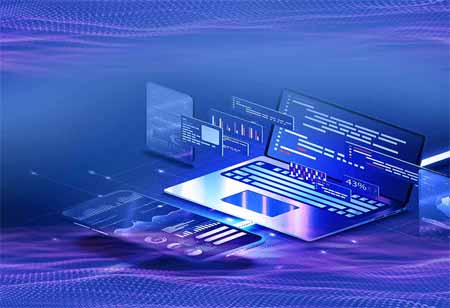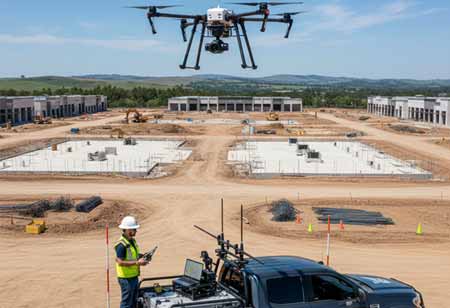THANK YOU FOR SUBSCRIBING
Be first to read the latest tech news, Industry Leader's Insights, and CIO interviews of medium and large enterprises exclusively from Applied Technology Review
Investing in Geospatial Technologies: Trends and Opportunities
In the fast-paced world of digital businesses, organizations are prioritizing innovative solutions to sustain competitiveness.

By
Applied Technology Review | Tuesday, February 20, 2024
Stay ahead of the industry with exclusive feature stories on the top companies, expert insights and the latest news delivered straight to your inbox. Subscribe today.
Geospatial data drives innovation across industries, offering insights for informed decisions. Investments surge in smart cities, agriculture, and new technologies.
FREMONT, CA: In the fast-paced world of digital businesses, organizations are prioritizing innovative solutions to sustain competitiveness. Geospatial data enriches this endeavor by furnishing valuable insights into customer behavior, market trends, and operational efficiencies. Harnessing such data enables businesses to make informed decisions, streamline operations, and adapt to dynamic market conditions promptly. This strategic utilization of geospatial data encompasses from sourcing reliable geospatial data to integrating cutting-edge technologies and best practices.
Geospatial data, also known as spatial or geographic information, includes a wide range of details related to Earth's surface locations. This information, acquired through satellites, GPS devices, and various technologies, comprises coordinates, shapes, sizes, and characteristics of geographic features.
Understanding Geospatial Data
Geospatial data is characterized by three fundamental dimensions. Firstly, Spatial data establishes the basis by defining the position and configuration of geographic elements. Complementing spatial data, attribute data provides additional details like names, population statistics, and economic metrics. Lastly, temporal data provides time-related information, enabling trend examination and prediction through monitoring temporal shifts.
Practical Applications of Geospatial Data across Various Business Domains
The practical applications of geospatial data across various business domains are extensive and transformative. For instance, in marketing, geospatial data transforms campaigns through highly targeted advertisements based on precise audience locations, thereby maximizing ROI and campaign effectiveness. Similarly, in supply chain management, geospatial data optimizes delivery routes and tracks goods movement, leading to cost savings and heightened customer satisfaction.
Moreover, real estate professionals leverage geospatial data to analyze property values, growth trends, and location desirability, empowering informed decision-making in property transactions. In environmental monitoring, geospatial data facilitates the assessment of deforestation, climate change impacts, and disaster management efforts. Additionally, in urban planning and development, geospatial data plays a pivotal role in mapping urban areas, identifying infrastructure needs, and promoting sustainable development in burgeoning cities.
Advantages of Geospatial Data
Leveraging geospatial data offers businesses a wide range of benefits.
Initially, geospatial data enriches decision-making by granting access to precise and current information, empowering informed decisions concerning market expansion, branch openings, and supply chain enhancement. Consequently, it promotes enhanced customer interaction through location-targeted marketing, customizing offers and details to elevate the customer journey. Additionally, geospatial data-driven operational enhancements result in cost reductions and operational streamlining. Ultimately, facilitating rapid adjustment to market shifts and efficient decision-making contributes to geospatial data's role in furnishing businesses with a competitive edge.
How To Implement Geospatial Data Effectively?
Businesses should focus on gathering relevant data from reliable sources, including demographics, market trends, and geographical features. It is therefore necessary to do thorough data analysis using specialist tools or professional advice to identify patterns, trends, and opportunities. Optimizing the value of geospatial data requires its integration across several corporate areas, such as supply chain management, marketing tactics, and decision-making processes. Lastly, ensuring that the team is proficient in utilizing geospatial data tools and technologies through comprehensive training is important.
Investment Trends and Opportunities
The utilization of location intelligence is powering industries across various sectors, presenting unparalleled investment opportunities and shaping regional trends.
Smart Cities: Governments worldwide are heavily investing in smart city initiatives, necessitating detailed geospatial data for infrastructure planning, traffic management, and resource optimization. This surge in demand opens avenues for investments in data acquisition, analysis platforms, and AI-powered solutions tailored for smart city development.
Precision Agriculture: The agricultural sector is increasingly relying on geospatial data to monitor soil health, optimize crop yields, and track livestock. This trend drives investments in satellite imagery, drone-based data collection, and agricultural analytics platforms, catering to the evolving needs of modern farming practices.
Logistics and Supply Chain: In the logistics and supply chain industry, optimizing delivery routes and enhancing visibility throughout the supply chain is paramount. Geospatial data plays a crucial role in achieving these objectives, attracting investments in fleet management solutions, real-time tracking platforms, and geospatial optimization tools to streamline operations and improve efficiency.
Rise of New Technologies
High-resolution Satellite Imagery: Advancements in satellite technology yield highly detailed and cost-effective imagery, spurring investments in satellite constellation operators, data processors, and AI-driven image analysis solutions. This surge in demand for superior geospatial data fuels innovation and market growth, driving various sectors to capitalize on the opportunities presented by these cutting-edge capabilities.
LiDAR and Drones: LiDAR and drone technology provide precise 3D mapping, opening avenues for companies offering data acquisition services, industry-specific drone solutions, and data processing platforms. These innovations cater to diverse business sectors, facilitating accurate spatial analysis and informed decision-making. As demand grows, opportunities abound for firms to deliver tailored solutions that optimize efficiency and productivity across industries.
Internet of Things (IoT) Integration: Integrating geospatial data with IoT sensors generates valuable real-time information for businesses. This integration drives investments in sensor development, data management platforms, and AI-powered solutions for analyzing sensor data alongside geospatial information, enabling businesses to make data-driven decisions more effectively.
Sustainability and Environmental Monitoring
Climate Change Solutions: Monitoring deforestation, tracking carbon emissions, and assessing climate risks are crucial for addressing climate change.
Geospatial data plays a vital role in these efforts by providing critical insights, enabling accurate mapping of deforestation, carbon emissions tracking, and climate risk assessment. It facilitates informed decision-making and targeted interventions to mitigate the impact of climate change effectively.
Additionally, geospatial data's importance attracts investors in Earth observation platforms, such as satellites and drones, as well as in environmental data analysis solutions like GIS software. AI-powered tools, leveraging geospatial data, enhance climate modeling accuracy, aiding in informed decision-making and global sustainability efforts.
Disaster Management: Effective response and preparedness for natural disasters depend on accurate geospatial data. This creates opportunities for companies providing real-time flood mapping, evacuation route planning tools, and post-disaster damage assessment solutions to enhance disaster management capabilities globally.
Renewable Energy Development: Identifying optimal locations for renewable energy projects requires detailed geospatial analysis. This trend spurs investments in geospatial data platforms, resource assessment tools, and AI-powered siting solutions to support the expansion of renewable energy infrastructure and promote sustainable energy development worldwide.
However, navigating the regulatory landscape effectively necessitates comprehending data privacy regulations and access restrictions in different APAC countries. Ensuring reliable and standardized data sources is significant for successful investment in the geospatial sector to maintain data integrity and accuracy. In addition, collaborating with local players who possess a deep understanding of the specific needs and challenges of the region facilitates valuable insights and aids successful investment strategies in the APAC geospatial market.
I agree We use cookies on this website to enhance your user experience. By clicking any link on this page you are giving your consent for us to set cookies. More info








